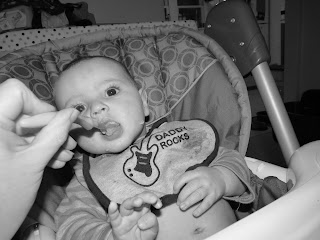Ok, so we were very VERY low on baby food and my husband had been saying to me all week that we needed to get more stuff to make. I went to Sendik's (local high end grocery store) and got a bunch of items, in fact I may have gone over-board! Balin is 8.5 months now so he doesn't need smooth purees, but I still enjoy making baby food for him. He loves just about anything we give him, actually I don't think we have found anything he doesn't like.
I usually go to Pick N Save to get a majority of my groceries, but to be honest, I haven't been impressed with the quality of their produce. Sendik's is good quality, sometimes you have to pay extra for that quality. But, they had organic broccoli on sale this week $.50 cheaper than non- organic! Their fruit generally looks and tastes better too. With that being said, I wanted to mention buying produce in season. Yes, you can get just about anything all year round as our grocery stores usually get items from place like Chile or Mexico. I have not been able to find peaches, even at Sendik's. There are reasons for this, primarily that cases of peaches are very expensive for the grocery store to buy making it even more expensive for the consumer, therefore it's not worth it for them to spend the money when no one is going to buy. For all of you "Pinteresters" out there, you may have seen this chart, and yes, I know it's from the UK, bit it's good general guideline for when fruits and vegetables are in season:
http://pinterest.com/pin/44191640063565117/
 |
| The Before... |
So, as I said, I went a little overboard. Oops! I made carrots, asparagus, broccoli, sweet potatoes, butternut squash, lentils, and garbanzo beans. :) I pureed these to a chunky consistency since he is older now and can chew a bit. Now, I started at about 1 pm and finished at about 5:30. It sounds like a long time, but we ran out of containers and I had to send DH out for more and I had a teething little guy to contend with. In a previous blog entry, I talked about the containers I use. I use Glad 4 oz storage containers. They are BPA free and dishwasher, microwave, and freezer safe. They are also a lot cheaper than containers dedicated to baby food.
 |
| The containers we use look like this. The small round ones are 4 oz Glad containers and the rectangle ones are Ziploc 9 oz containers. Target was out of the Glad 8 oz containers. |
 |
| The After... |
When it comes to deciding whether to buy dried items vs. canned, such as garbanzo beans, I always get dried. Canned items have lots of salt in them to preserve freshness, even if you get the low sodium version. You can also opt for frozen. I generally get frozen lima beans, steam and puree or dice them. As a general rule of thumb, stay away from anything canned for your child. It isn't hard to bring beans and legumes from a dried state to rehydrated state, I will talk about this in my next blog entry. :)


















